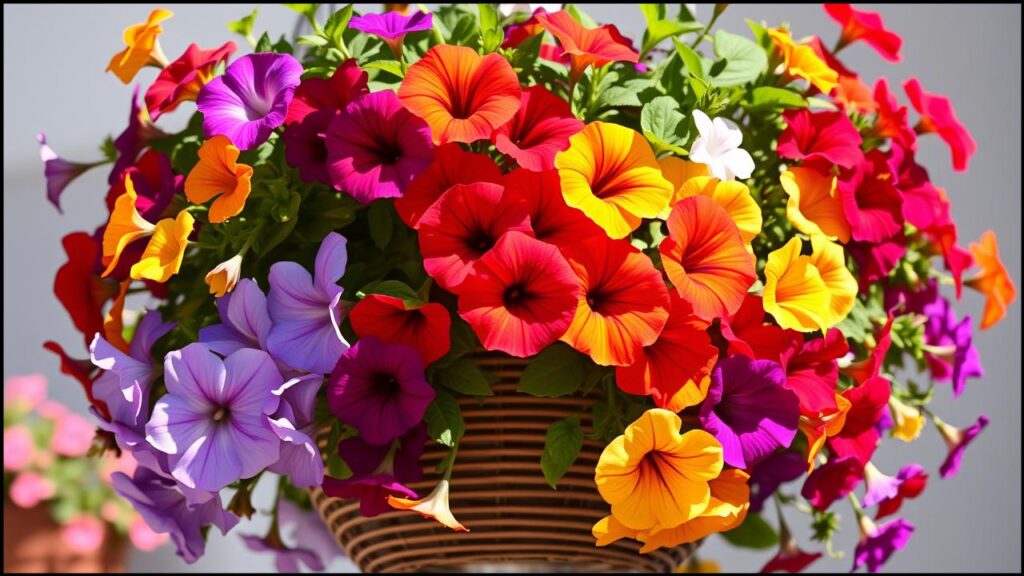
Petunias. Just the name evokes images of overflowing flower boxes, vibrant garden borders, and hanging baskets dripping with cheerful color. These beloved annuals are true workhorses of the summer garden, capable of producing an astonishing profusion of blooms. But how do you keep that floral magic alive, ensuring your petunias are the envy of the neighborhood not just in June, but all the way through September and even into the first whispers of frost? It’s all about consistent, thoughtful Petunia care. This guide will unveil the essential techniques and a few of my most trusted secrets to transform your petunias into season-long superstars. Get ready for a garden that truly sings with color!
Quick Tips for Petunia Brilliance
Short on time? Here’s what you need to know for a spectacular petunia season:
- Sun is King: Provide at least 6-8 hours of direct sunlight daily.
- Feed Regularly: Petunias are hungry! Use a balanced liquid fertilizer every 1-2 weeks.
- Deadhead Diligently: Remove spent blooms to encourage new flower production.
- Water Wisely: Water deeply when the top inch of soil is dry; avoid soggy roots.
- Consider a Mid-Season Haircut: For leggy plants, a good trim can rejuvenate growth.
Why Petunias Deserve a Prime Spot in Your Garden
Petunias offer an incredible return on investment for any gardener. Their versatility is simply unmatched. Whether you’re aiming for luxurious, trailing cascades from window boxes and hanging baskets, or vibrant, mounding forms to edge your pathways and fill your beds, there’s a petunia variety perfectly suited to your vision. Their color palette is astounding, ranging from the softest pastels to the most electrifying jewel tones, including velvety blacks and vibrant limes. Many varieties also offer a delightful, subtle fragrance, especially in the evening.
In my own garden, I rely on petunias to be the backbone of my summer container designs. Their relentless blooming power fills in gaps and provides continuous color when other plants might be taking a breather. They are, quite simply, a joy to grow and a feast for the eyes.
Choosing Your Champions: Varieties for Endless Blooms
While most petunias are eager to please, some varieties are bred specifically for exceptional vigor and long-blooming petunias performance. When you’re selecting your plants, look for these types:
- Wave Petunias (Petunia x hybrida ‘Wave’ series): These are iconic for a reason. Spreading and trailing, they are fantastic for groundcover, large containers, and hanging baskets. They are generally more self-cleaning (less deadheading needed) than older types. Popular series include Wave®, Easy Wave®, and Tidal Wave®.
- Supertunias® (Petunia ‘Supertunia’ series): Developed by Proven Winners, these are bred for exceptional weather tolerance, disease resistance, and prolific blooming. They come in a vast array of colors and habits, from mounding to vigorous trailers. I’ve found Supertunia Vista® varieties to be particularly robust.
- Surfinia® Petunias (Petunia x hybrida ‘Surfinia’ series): Known for their vigorous trailing habit and excellent rain tolerance, Surfinias are mainstays for breathtaking hanging baskets.
- Grandiflora vs. Multiflora vs. Milliflora:
- Grandifloras boast large, showy flowers (up to 5 inches) but can be more susceptible to rain damage. They sometimes require more diligent deadheading petunias.
- Multifloras have smaller, more numerous blooms and tend to be more weather-tolerant and compact.
- Millifloras (or floribundas) offer a profusion of tiny, dainty flowers on compact plants, perfect for edging or small containers.
When purchasing, look for healthy, compact plants with bright green foliage and plenty of buds, rather than those already leggy or stressed.
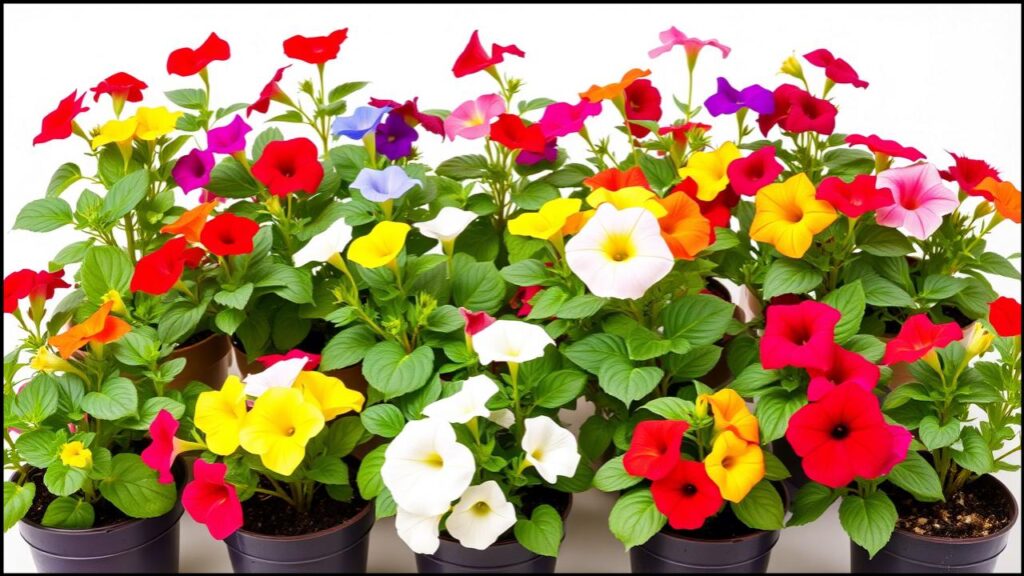
The Foundation of Floral Success: Planting Petunias Right
Giving your petunias a strong start is the first step towards a season of spectacular blooms.
Location, Location, Location: Petunias are sun worshippers. For the most prolific flowering, select a spot that receives at least six to eight hours of direct sunlight each day. Less sun will result in fewer blooms and leggier plants. In my experience, morning sun with some afternoon shade in intensely hot climates can be beneficial, but full sun is generally the rule.
Soil Preparation: Whether planting in the ground or in containers, petunias thrive in well-draining soil rich in organic matter.
- In Garden Beds: Amend your soil with compost or well-rotted manure to improve its texture and fertility. If you have heavy clay soil, adding organic matter is crucial for drainage. The University of Minnesota suggests tilling in 2-3 inches of compost before planting.
- In Containers: Use a high-quality, peat-based potting mix. These mixes are formulated to provide good aeration and drainage, which is vital for preventing root rot. Ensure your containers have ample drainage holes.
Planting Technique: Gently remove the petunia from its nursery pot, teasing out any circling roots. Plant it at the same depth it was growing in its original container. Space plants according to their mature size – typically 12 inches apart for most varieties but spreading types like Wave petunias may need more room, up to 18-24 inches. Water thoroughly after planting to settle the soil.
The Secret to Non-Stop Flowers: Mastering Petunia Care
Once established, consistent care will keep your petunias performing their best. This is where the real magic happens, transforming good petunia growth into a breathtaking, continuous floral display.
Sunlight: The Unwavering Demand
As mentioned, sunlight is non-negotiable. If you notice your petunias becoming sparse and leggy with few flowers, insufficient sunlight is often the primary culprit. Monitor the sun patterns in your garden throughout the day to ensure they’re getting their fill.
Watering Wisdom: Quenching Their Thirst, Not Drowning Their Roots
Proper watering is crucial. Petunias dislike “wet feet,” which can lead to root rot and other fungal diseases.
- Frequency: Water when the top inch or two of soil feels dry to the touch. In the heat of summer, container-grown petunias may need watering daily, sometimes even twice a day for smaller pots.
- Technique: Water deeply at the base of the plants, allowing water to soak down to the root zone. Avoid overhead watering, which can promote fungal diseases on the foliage and flowers.
- Container Considerations: Plants in containers, especially hanging baskets exposed to wind, dry out much faster than those in the ground. Check them frequently. Self-watering containers can be a fantastic option if you struggle with consistent watering.
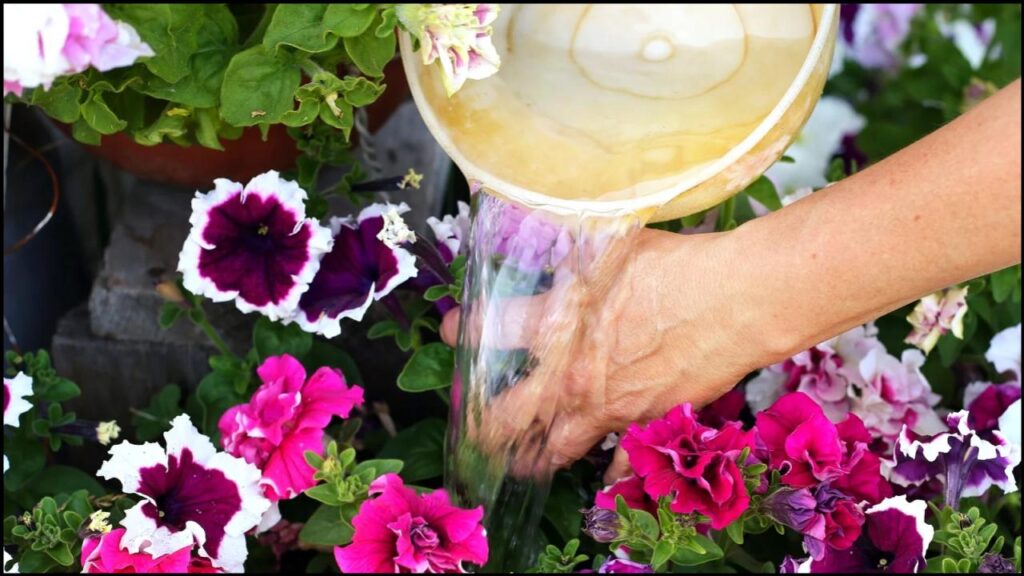
Feeding for Flourishes: The Art of Fertilizing Petunias
Petunias are heavy feeders. Their rapid growth and prolific blooming require a steady supply of nutrients. Without adequate fertilization, their flower production will inevitably slow down.
- Initial Boost: Incorporating a slow-release granular fertilizer into the soil or potting mix at planting time provides a good baseline of nutrition.
- Regular Liquid Feeding: For the most impressive display, supplement with a balanced, water-soluble fertilizer every one to two weeks throughout the growing season. Look for formulations designed for flowering plants, such as those with a ratio like 20-20-20 or one higher in phosphorus (the middle number), which supports bloom development. I often use a diluted fish emulsion or seaweed fertilizer for an organic boost.
- Follow Directions: Always follow the product label instructions for mixing and application rates. Over-fertilizing can burn roots and harm your plants.
The Clemson Cooperative Extension Home & Garden Information Center emphasizes that regular fertilization is key for maintaining vigorous growth and flowering, especially for petunias in containers where nutrients leach out more quickly.
The Kindest Cut: The Magic of Deadheading Petunias
This is perhaps the most impactful “secret” to continuous blooms. Deadheading petunias – the simple act of removing faded or spent flowers – prevents the plant from setting seed. When a plant focuses energy on seed production, it naturally reduces its flower output.
- How to Deadhead: Pinch or snip off the faded bloom, including the little swollen area (the developing seed pod) at its base. For some varieties, especially grandifloras, you’ll want to follow the flower stem back to the main stem or a leaf node.
- Frequency: Make deadheading a regular garden ritual. A few minutes every day or two is far more effective than a massive cleanup once a week.
- Self-Cleaning Varieties: Many modern hybrids, like some Supertunias® and Wave® petunias, are touted as “self-cleaning,” meaning the spent flowers wither and fall off more readily without forming prominent seed pods. While they require less intensive deadheading, an occasional cleanup will still benefit their appearance and performance. I find that even self-cleaning types appreciate a little help now and then.
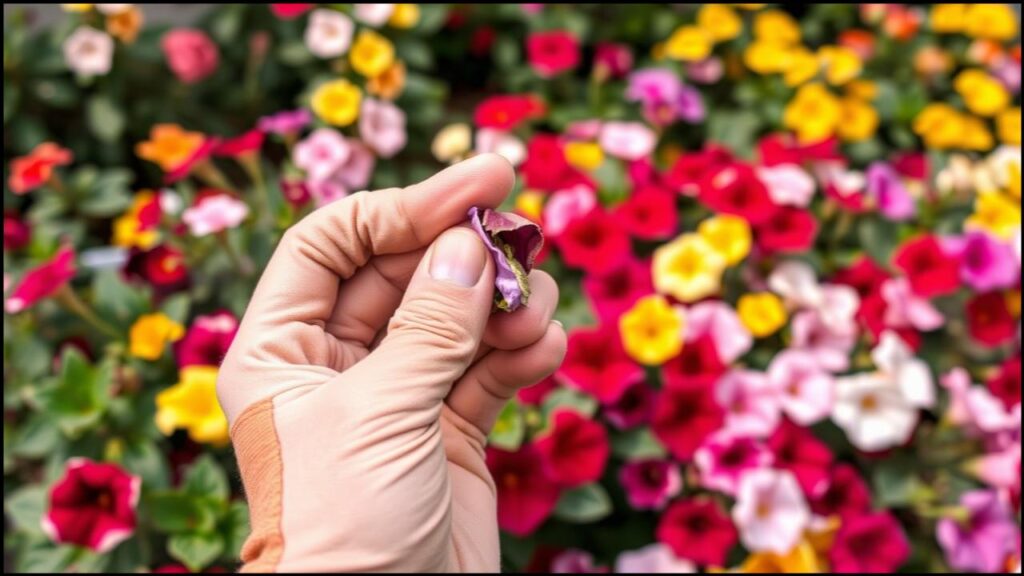
The Mid-Season Refresh: A Rejuvenating Prune
By midsummer, even the best-cared-for petunias can start to look a bit leggy, straggly, or tired, with blooms concentrated at the ends of long stems. Don’t despair! A “mid-season haircut” can work wonders.
- The Technique: Using clean, sharp scissors or pruners, cut back up to one-third or even one-half of the plant’s growth. It might seem drastic, but this encourages the plant to branch out from lower down on the stems, resulting in a fuller, more compact plant with a fresh flush of blooms.
- Timing: Typically, this is done in late July or early August, or whenever your plants start to look like they need a pick-me-up.
- Post-Pruning Care: After pruning, give your petunias a good dose of fertilizer and water well. You should see new growth and flowers emerging within a week or two. This is a trick I use year after year to ensure my petunias look fantastic well into autumn.
Troubleshooting Common Petunia Problems
Even with the best care, you might encounter a few issues. Here’s how to tackle them:
- Leggy Growth, Few Flowers:
- Cause: Insufficient sunlight is the most common reason. Also, lack of regular fertilization or neglecting deadheading.
- Solution: Move to a sunnier spot if possible. Implement a regular fertilizing schedule and be diligent about deadheading petunias. A mid-season prune can also correct legginess.
- Yellowing Leaves (Chlorosis):
- Cause: Often an iron deficiency, especially in alkaline soils or from overwatering which can hinder nutrient uptake. Can also be nitrogen deficiency.
- Solution: Check soil moisture. If consistently wet, allow it to dry out more between waterings. Apply a liquid feed containing chelated iron or a balanced fertilizer.
- Aphids or Spider Mites:
- Cause: These common pests suck plant juices.
- Solution: A strong spray of water can dislodge them. For heavier infestations, use insecticidal soap or neem oil, following label directions. Encourage beneficial insects like ladybugs.
- Powdery Mildew:
- Cause: A fungal disease appearing as a white, powdery coating on leaves, often in humid conditions with poor air circulation.
- Solution: Improve air circulation by proper spacing. Water at the base of plants. Apply a fungicide if necessary, choosing an organic option if preferred.
- Budworms (Petunia Worms):
- Cause: Small caterpillars that chew holes in buds and flowers.
- Solution: Handpick them off. Bacillus thuringiensis (Bt), an organic insecticide, is effective against caterpillars.
A common mistake I see is gardeners overwatering their petunias out of kindness, which unfortunately leads to more problems than it solves. Always check that soil before reaching for the watering can!
Styling with Petunias: From Cascading Baskets to Elegant Borders
Petunias are incredibly versatile for creating stunning garden vignettes:
- Hanging Baskets & Window Boxes: This is where trailing petunias truly shine. Combine different colors of petunias for a vibrant mix, or pair them with other trailing plants like calibrachoa (million bells), sweet potato vine (Ipomoea batatas), or bacopa. My go-to for a dramatic look is a monochromatic scheme with varying shades of purple and pink petunias.
- Containers & Urns: Use mounding petunias as “fillers” and “spillers” in mixed containers. Pair them with taller “thriller” plants for height and drama.
- Garden Beds & Borders: Mass plantings of mounding or spreading petunias create a carpet of color. Use them to edge pathways or fill in gaps between perennials.
- Color Themes: Create sophisticated color palettes. Imagine an all-white moon garden featuring white petunias, or a fiery mix of red, orange, and yellow blooms.
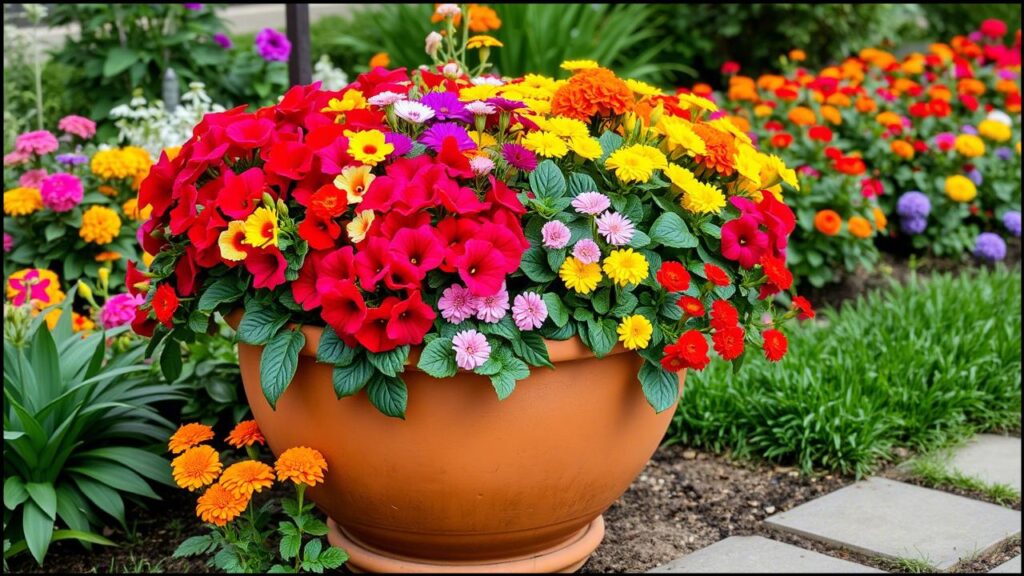
Preparing for the Inevitable: Extending the Show into Autumn
As summer wanes and cooler nights arrive, your petunias might experience a renewed burst of energy.
- Continued Care: Don’t abandon your Petunia care routine. Continue deadheading, fertilizing (perhaps at half strength), and watering as needed.
- Light Frost Protection: If a light, early frost is predicted, you can often protect your petunias by covering them overnight with a lightweight fabric sheet or frost cloth. This can give you several more weeks of enjoyment.
- Bringing Small Pots Indoors: While petunias are generally treated as annuals, you can sometimes overwinter them indoors in a very sunny spot, though they may not perform as well the following year and can get leggy. Most gardeners prefer to start with fresh plants each spring for the best display.
Tools and Materials for Petunia Paradise
Having the right tools makes any gardening task more enjoyable and effective:
- Watering Can or Hose with Wand: For targeted watering at the base of plants.
- Sharp Pruners or Small Scissors: Essential for clean cuts when deadheading and pruning.
- Quality Potting Mix: For container planting.
- Balanced Liquid Fertilizer: The key to continuous blooms.
- Slow-Release Granular Fertilizer: For an initial nutrient boost.
- Gardening Gloves: To keep your hands clean and protected.
- Appropriate Containers: Ensure they have good drainage holes.
A Season of Unending Beauty
With a little consistent attention to their needs – ample sunshine, regular nourishment, timely sips of water, and the crucial art of deadheading – your petunias will reward you with an extravagant, season-long spectacle of color. From the first warm days of late spring right up until the crispness of autumn air signals the first frost, these floral champions can truly transform your garden spaces. My hope is that these insights into Petunia care empower you to cultivate the most breathtaking petunia displays you’ve ever had. Now, go forth and let the blooming commence!
